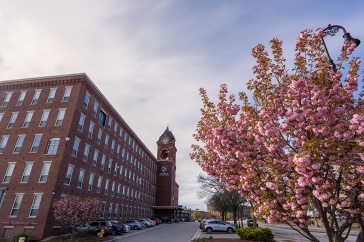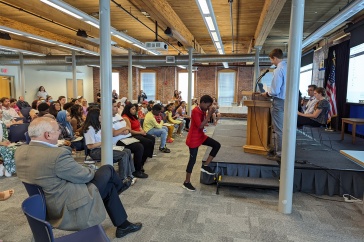
More than 100 people attended a town hall discussion Wednesday to review a new report from the civic group Manchester Connects, detailing potential cultural and economic development initiatives for the Queen City’s downtown and Millyard areas.
The report was created using community input culled from a series of public meetings and workshops over the past year and a half, where more than 200 city residents shared ideas and visions for the future of the state’s largest city.
Wednesday’s town hall discussion was held at the University of New Hampshire at Manchester. The study was underwritten with local financial support and a federal grant to the Southern New Hampshire Planning Commission, which secured the Boston-based consulting firm Civic Moxie to compile data.
John Clayton, executive director of the Manchester Historic Association and a Manchester Connects volunteer, said the report “is a blueprint for making our community a more vital, inviting place.”
“When the Millyard and downtown thrives, we all win,” said Mike Skelton, president and chief executive officer of the Greater Manchester Chamber of Commerce.
“We need to do more as a city to not lose the momentum we’ve got going,” said Arthur Sullivan, principal partner of Manchester-based Brady Sullivan Properties. “We have people here. We have people that want to be here. We need to get started.”
The five goals detailed in the report are:
• Create vibrant public spaces.
Manchester would benefit from more social destinations downtown, in the Millyard and on the West Side. Businesses, community groups and city government can add tremendous social capital by working together to create a mix of events and inviting spaces that encourage people to move throughout the community, resulting in greater social and businesses connections.
• Promote complete streets design and multimodal transportation choices.
Research shows that the more street intersections that exist, the more opportunities there are for human interaction and vitality. With more than 98 percent of Millyard employees driving to work alone or in a carpool, upgrading streets so they are more welcoming for pedestrians, bicycles and transit can put more people on the city’s sidewalks, adding to vitality and providing foot traffic for businesses while also easing demand on parking.
• Support mixed land uses and smart parking strategies.
The Millyard is predominately office and educational land uses. Dining options are few and the limited number of residential buildings doesn’t provide enough residents to support the range of active ground-floor uses that would draw more activity and animate the street life of the area. An integrated solution to land uses and parking strategies can help solve some of the challenges of an inactive ground floor and put more property into economic use.
“Right now, parking is driving the decision-making in the Millyard,” said Susan Silberberg, founder of Civic Moxie. “As a city, you should never be in a situation where parking is driving all the decision-making.”
•Sustain the “Manchester Connects” organization long-term.
Manchester is teeming with entrepreneurs, civic leaders, collaborators and energy. To make the most of those resources, people need to stay connected with one another. By facilitating connections among the people and institutions that want to make Manchester a better place to live, work and play, this organization will be a catalyst for the city’s future development.
• Build a world-class Riverwalk and iconic pedestrian bridge.
Active and well-designed urban waterfronts around the world support economic development and enhance livability. Manchester has a wonderful river, but its riverfront was never developed as a recreation area. Without a vibrant Riverwalk and second pedestrian bridge, the river will remain an underdeveloped asset. These amenities will build community spirit and connections while attracting the young people Manchester needs to grow. Businesses, in turn, will follow.
“Right now the Riverwalk is .3 miles,” said Clayton. “That’s more of a River Stroll than a Riverwalk. Why can’t we expand that?”
Organizers urged anyone wishing to get involved in the revitalization effort — including developing fundraising efforts — to visit http://ahlasny4.wixsite.com/manchesterconnects.
This artical was orginially published in the Union Leader November 2, 2017.




















































